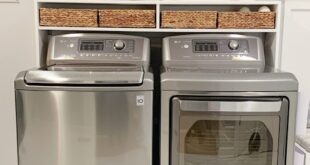Okay guys, if you have been following us on our socials, you know that we installed marble tile on the floor and wall, where the washer and dryer are planned to go… I wanted to jump on here and give you a quick update to where we are with the project and some tips we learned along the way of putting tile on the floor and on the wall. Another thing I wanted to share is a MAJORLY affordable tile source that I found. I was on the hunt for a more affordable option for this space & when I found this source I thought it could be a scam because it was so affordable, but I found out it’s legit & we are super happy with the product so I wanted to share that with you guys…

As you can see the tile is far from finished, but progress is key! We have ordered marble trim for the floor and ceiling joints. We will also be tiling more of the room as well, but this was the biggest part we had to complete.

The tile we are using are 4×8 Carrara White Marble Honed. And we purchased it all online from The Stone Center Online. Before we put tile down we first laid Hardie Backer Cement board on the floor and also, on the wall. If you have never installed cement board, typically there are cement board screws with a size chart near the cement boards at the big box stores.
Next we do the prep work of title placement. We found the center of the floor and wall from two directions. So we know the very center of each surface that we are working on. Using a chalkline, we snapped a line for reference. Our space was relatively small and very close to being square and level. For large spaces some people like to snap quadrant chalk-lines in the areas they are placing tile to maintain square and level tile placement in reference to the space.

Tip 1: Do a Dry Run Placement of a row and column to see how the tiles will meet up to adjacent walls and transitions in flooring.
Before we get the thin-set out, we checked our placement by doing a “dry run” starting in the center point and placing the tiles next to each other with tile spacers between (as if you were installing the tiles). What we were checking, is to see how naturally the tiles layout and meet the adjacent walls and transitions in flooring. What we are hoping for is the provided space in the room, and the dimensions of our tile allows for roughly a third of the tile (or larger) to run into the wall.
If you don’t like how the tile naturally meets the wall from the very center, you can adjust your center line accordingly and do another dry run. What we are trying to avoid is being left with having to cut a thin sliver of stone. We will be installing baseboard to cap off our edges so we have to keep in mind baseboard dimensions and the recommended 1/8 minimum gap from adjacent walls to allow for seasonal movement.
Tip 2: Pull your tile out of the boxes and shuffle them around to help disperse color and pattern variations.
Once we were happy with the placement, it is good practice to pull out the tiles you are going to use and “shuffle” them up. This will help disperse any similarities in patterns from one box to another. Sometimes one or two boxes can have a slight variance from the other (i.e. a brighter white color), by shuffling the tiles, it will allow for those all to be mixed into the floor and wall design rather than having a noticeable grouping of variations in sections of the design.

Tip 4: Picking the right Mortar or Modified Mortar
Now for the thin-set or mortar. If you are taking on your own tile install, the tile distributor should have recommend adhesive procedures. Some applications ask for mortar and some for modified mortar or thin-set. From an affordability standpoint the bagged mixtures that require a bucket and water is best, and I believe used by most professionals. Since we are not everyday tilers, we wanted to ensure we had a good mixture and consistency so we purchase the no-mix required thin-set for our job, but it does come with a significant higher price tag.
Tip 3: Work is smaller sections until you are comfortable with the process and work bigger as you get comfortable.
The tools we used were a 1/4 inch x 1/4 inch x 1/4 inch square-notched flooring trowel, 2 inch x 6 inch notched margin trowel, 6 inch x 2 inch flat margin trowel, and universal gum rubber float for the grout. We generally spread our thin-set in a 2 feet by 4 feet area, we felt comfortable with that throughout the project. We followed the direction on the thin-set container and spread out with the flat edge of the notched flooring trowel and margin trowel. Troweled the thin-set and placed the tile onto. Since we did a lot of prep work, I actually started in the very center of the room and worked to the walls and corners. This allowed for me to easily work around the tiles and back deep in the corner where I could reach without having to step on the tiles. For the wall, we started from the very bottom since we were going to be putting crown molding at the top to hide joint of tile and ceiling.
From there it is essentially a wash and repeat with spreading the thin set and placing the tiles onto, and checking for level. For spacing we used 1/8 inch rubber spacers. After few little sections it is always good practice to measure or check where the tiles are in reference to your centerline or measure from one edge of the tile to another to see if its squared to the space.
Once you are done with the tile install we let the floor and wall cure as recommended by the thin-set containers. We applied our grout using a grout float. Once all is installed and grouted we did a final clean of the tile with water and are ready for the baseboard to be installed.

The tile isn’t fully cleaned and we may have a grout update coming very soon, but I did want to show you that the tile is up and we are making progress in this space! We will hopefully have more big updates in this space very soon for you guys. THANK YOU for stopping by the blog today & every single day to see what we are up to. It means the world to us! xx



